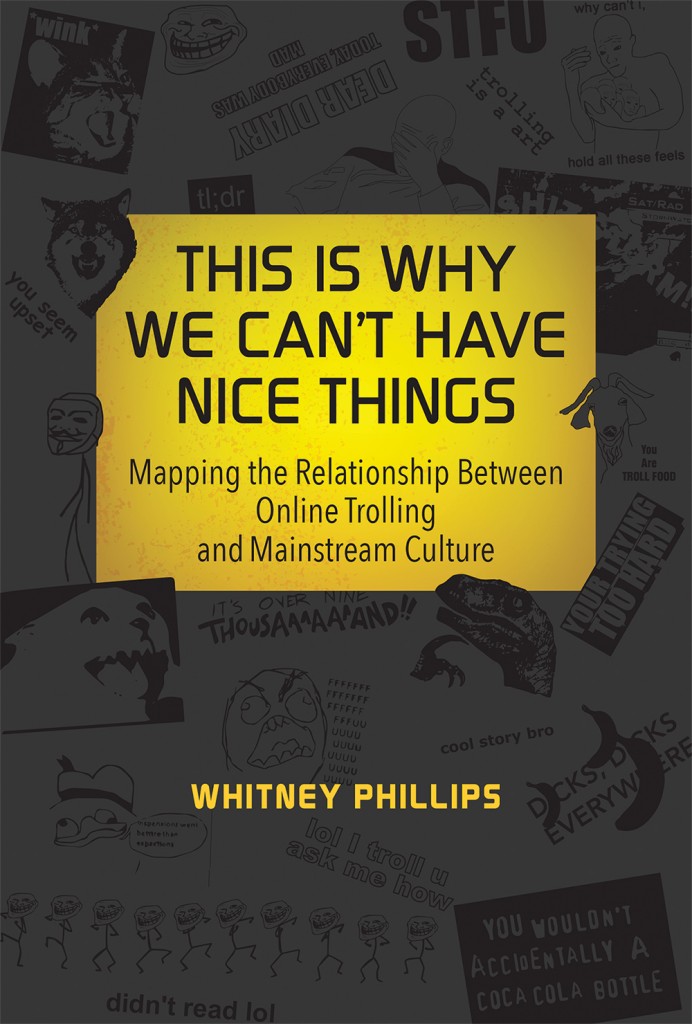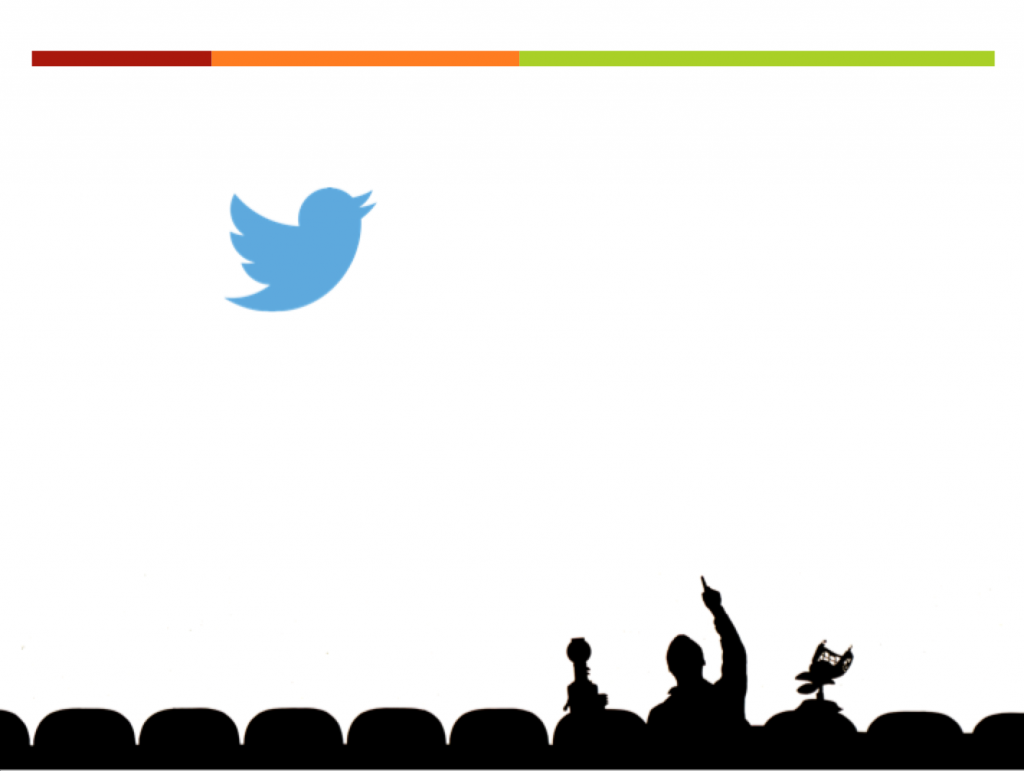In 2014, I was putting the final editing touches on my book on internet trolls. Having never published a book before, I didn’t realize how involved the process would be, not just regarding the text itself but the book cover as well. I’d provided some cover design ideas on one of MIT’s author questionnaire forms, but otherwise didn’t know what to expect. And when the proofs arrived, I was…concerned.

Side by side comparison of first draft book covers, precipitating a flurry of confusion over that bottom-right banana, which apparently was for scale.
I liked the design itself, but the memes included on the cover were dated and overplayed. While some had started within or at least had been embraced by subcultural trolling circles (“cool story bro,” trollface, philosoraptor), their subcultural appeal had long been overshadowed by their mainstream ubiquity. They had, to use a highly non-scientific framing, become Facebook memes. Untethered to any specific culture or community. Too dated and too overplayed, even, for hipster irony. My immediate response to which was oh shit. Facebook memes?! I’d never hear the end of it.
Mildly panicked, I reached out to my frequent collaborator and friend Ryan Milner, incidentally the co-editor of this Culture Digitally series. I asked him what he thought of the cover. Part of his answer, copied and pasted from our text exchange, was as follows:
can you just be like ‘the cool kids won’t like this and there’s a reason for that’
OR
okay if we’re leaning into bad then use all THESE images and phrases and we’ll get so bad it’s cool
I ended up raising the first point (phrased more academically of course) and advocating for a modified version of the second, and over the next week worked with MIT’s very gracious and understanding designer on a mosaic-style cover featuring “old school” trolling memes.
Unlike the first set, these memes winked at trolling culture without making it seem like I was trying to pass off any of the images as the hot new trend with America’s teens. In some ways, I was daring my readers to question my memetic choices, and to that point, had the designer include the phrase “you seem upset” written in Comic Sans, which in trolling circles is equally celebrated and reviled for being the least cool typeface in history. I even got the press to throw in some swears on the cover itself (shitstorm, STFU, even a well-placed dick joke). So thumbs up, I got a cover I liked, and the book was published as scheduled.
I lead with this story to highlight the often-strange relationship researchers of up-to-the-minute pop cultural content—whether the content is properly subcultural or just massively popular—have with their object of study. All researchers seek, and sometimes struggle, to accurately represent their object of study, but “cool” content, content that falls under the mantle of “what’s trending,” poses an additional complication: namely the desire, and really the need, to navigate—to capture—coolness in one’s work. Or at the very least, attempt not to seem uncool, or generally out of the loop. As my reaction to my book cover attests, my own work is absolutely a site of this tension. In this particular case and in many cases before and after, I’ve found myself worried that readers, including other academics, will sneer at my choice of examples. Or even my choice of subjects (a colleague once mused that it’s too bad my book was coming out now, after trolling stopped being a thing—but he’d still teach it, you’re welcome).
To be fair to me and to all the other academics who worry about such a reaction (whether or not they admit it), this isn’t merely a concern about wanting to be seen as cool per se. There’s a certain degree of ego investment, sure. There always is. But it goes deeper than performing some high school sense of in-crowd, burn-book hair-flipping. It is a legitimate concern about performing literacy. The awareness of emergent trends. Expertise, in other words. As a researcher of popular/“trendy” participatory content, you don’t want to seem like you’re behind the curve, or are unaware of what’s really happening (and by extension, what’s really cool) in the communities you’re studying.
For one thing, this is a field where both academic and non-academic participants sure have opinions, and really talk back. Feel compelled to talk back, in some cases. Often to your face, on the very social media platforms you use to publicize your work (“professionalize,” 140 characters at a time—which often means responding to other academics’ work, and not always charitably because no one can see anything you post to Twitter at a conference, right?). And getting it wrong, or looking like you’ve gotten it wrong, can open you up to all stripes of ridicule. The snark-mongers on Mystery Science Twitter 3000 might not know (or care) that it’s taken three years to publish your article, thanks to the labyrinthian hellscape that is the peer review process. They just know that you’ve just published and/or are still talking about a thing that no one does anymore (and to my academic readers, you can pretend you don’t do this, but I have heard more of you than I can count chortling at conferences—in person, over Twitter, and on the various backchannels to the backchannels—because X researcher still studies Y and is using Z case studies like an idiot, because ha ha what is it, 2012?).
Concerns over cool aren’t just that, in other words. They also gesture towards the interdependent issues of timeliness, cordoning off a research focus, and the difficulty of writing about moving targets. As I discuss here (appropriately, in defense of memes), in the time it takes to research, write, and publish a project about a specific meme or community, participatory texts—or even the communities that first created and/or amplified these texts—often undergo profound transformation.
Sometimes these texts disappear from the cultural landscape entirely. Sometimes the texts are so successful that they lose their original audience and over the course of a research project go from being a platform-restricted subcultural phenomenon to an inescapable component of public life. And in the process, are often slurped up as cringe-worthy marketing fodder for those looking to sell soda or whatever to “the youth,” with their slangs and their pictures of the heads with the rainbows coming out, with words (hat tip to Ryan Milner, who discusses this case study in his forthcoming MIT book on memes). In the article linked above, I describe such memejacked content as “poochies,” in honor of the pandering Itchy and Scratchy character of the same name. Jumpcut to applicable 30 Rock Reference. God help you if your primary case study starts out as some underground, constitutive memetic joke and ends up featured in something like this anti-smoking PSA, for which there are literally no words (“All the facepalms!” the producers of this clip might shriek).
Not that you couldn’t follow up and discuss the transformation of an earlier case study; that’s been my catch-up game for the last six years. But what about those hot-off-the-press case studies that were dated before they were even published? (see: my entire dissertation). Do you qualify your research timeline say on Twitter, thus calling attention to your anxiety about how your work (and by extension yourself as a self-professed arbiter of relevance) is received? Or do you not qualify your research timeline on Twitter, thus risking seeming like you don’t know that it isn’t 2012 anymore? Choices, choices.
In short, the act of studying memes highlights a number of larger issues in and around academia. First, meme research calls attention to the inadequacy of our current publishing model in effectively disseminating time-sensitive research. Second, meme scholarship is acutely subject to and therefore highlights the ways in which hypermediation has collapsed time, such that one calendar year can see the rise, plateau, and fall of countless online subcultures and behavioral practices. Third, it foregrounds the very strange role social media plays in professionalization, and by extension, the process by which we academics police our own research choices and the research choices of others.
Fourth, and most significantly, meme research exaggerates the collapse between academics’ public and professional personae; those of us who study memes almost to the letter like memes, and likely have engaged in memetic practices, thus stacking our respective decks with personal proclivities, aesthetics, and affiliations that consciously or subconsciously influence how we approach the subject we are studying. Including the kinds of fences we’re inclined to erect around what “counts” as a meme. This in turn puts the researcher front and center in ways that can be simultaneously uncomfortable and difficult to characterize (meme research isn’t alone in this, of course, but to date hasn’t been broadly commented upon). Consequently, considering how and in what ways we complicate our research, and the ways in which our research complicates us, won’t just help us better understand the texts and communities we study. It will also help us better understand the people doing the studying.
The above is part 3 of 8 in a collection on internet memes and viral media compiled for Culture Digitally, based on a pair of panels at the 2014 and 2015 meetings of the International Communication Association. We’ve taken to calling it “The Culture Digitally Festival of Memeology” and will release two entries a week for the next month. We hope you enjoy the show.
– Ryan M. Milner and Jean Burgess, Collection Editors


